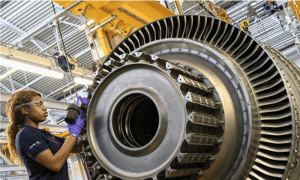 © Royal Air Force
© Royal Air Force
Royal Air Force’s II(AC) Squadron foils insurgent bombers in Afghanistan
by Royal Air Force from press release
| 2014/04/10 | 711 words
| AVIATION WORLD NEWS | DEFENCE
Two Royal Air Force Tornado GR4 fast jets from II(AC) Squadron have yet again protected civilians and Afghan-led international forces on the ground by scattering insurgents who were attempting to plant a roadside bomb ahead of an ISAF convoy. Using the advanced Litening III surveillance pod, on 10 March the aircraft helped ISAF troops capture and destroy a lethal quantity of explosives that could have taken the lives of civilians or security forces.
The jets’ aircrew spotted insurgents placing the deadly improvised explosive device (IED) just hundreds of metres ahead of the convoy of US and Afghan troops, which II(AC) Squadron had been called to support following an earlier IED blast. II(AC) Squadron pilot Flight Lieutenant Geoff Williams flew one of the aircraft above the convoy. He said: “Identifying insurgent activity from 10,000 feet can be challenging but in this case it was clearly suspicious. Two people on a motorbike rendezvoused with two others waiting by a small bridge. They collected items stored under the bridge and began digging in the road.”
Alert to the risk that the insurgents were planting a roadside bomb, Flight Lieutenant Williams flew an intimidating ‘show of presence’ over them – flying low and fast and firing flares to terrify and deter them and reassure the friendly convoy. He said: “Having been startled by our jet noise the insurgents fled by motorbike. The whole event was over in a minute. The presence of a Tornado provides a huge psychological impact, reassuring ISAF troops and the civilian population, and sparking fear in the insurgents.”
The Afghan-partnered ISAF convoy included troops from the Texas-based 2nd Battalion, 5th Infantry of the US 1st Armoured Division, known as the Old Ironsides. Sergeant Louis Awua, the unit’s forward air controller, said: “When the Brits do shows of presence they almost scrape the ground. They fly so low you don’t know what it means. What I like is the quality of the pilots and the quality of the sensors. They report everything that they see.”
II(AC) Squadron’s officer commanding, Wing Commander Jez Holmes, was piloting the second aircraft involved in the mission. The ISAF troops used data from his aircraft’s Litening III pod to locate and destroy the insurgents’ hastily buried bomb. Wing Commander Holmes said: “The troops found enough explosives to have caused multiple casualties among coalition forces or the local civilian population. It’s good to have removed that threat.”
Tornado GR4s are based at Kandahar Airfield as part of the RAF’s 904 Expeditionary Air Wing, and are routinely called on to support Afghan-led ground forces across Afghanistan. Although the aircraft can use precision weapons to target insurgents, many ‘contacts’ with the enemy can be broken using non-lethal shows of force and presence.
II(AC) Squadron weapon systems operator Flight Lieutenant Mark “Beppe” Hodgkiss said: “During this phase of the campaign in Afghanistan, Tornado GR4s are required to conduct more support to convoys as the forward operating bases close down. It can be difficult to make the call to stop a convoy as you don’t want them in vulnerable areas any longer than necessary, but this time it was clear cut.”
Litening III and the advanced Reconnaissance Pod Tornado (RAPTOR) provide the GR4 with a powerful ability to provide forces on the ground with up-to-the minute data to help commanders make well-informed decisions. Earlier in March II(AC) Squadron Tornado GR4s were involved in another life-saving operation using the Litening III pod, providing friendly forces with aerial surveillance of insurgents who were firing on them, pinpointing the enemy’s position to give friendly forces a tactical advantage.
The GR4s’ missions are commanded by operational experts from 83 Expeditionary Air Group (83 EAG), based in the Middle East. Wing Commander Graham Pemberton, Chief of Staff (Operations) at 83 EAG, said the GR4 played a vital role in ISAF air power. “Here at 83 EAG we can help to provide the aircraft with the ‘big picture’,” he said. “The IED incident is a fantastic example of the GR4’s flexibility, speed and capability. The UK air contribution to ISAF is extremely well respected within the Coalition, and it’s always satisfying to know our aircrew have made a real difference to our colleagues on the ground.”
The jets’ aircrew spotted insurgents placing the deadly improvised explosive device (IED) just hundreds of metres ahead of the convoy of US and Afghan troops, which II(AC) Squadron had been called to support following an earlier IED blast. II(AC) Squadron pilot Flight Lieutenant Geoff Williams flew one of the aircraft above the convoy. He said: “Identifying insurgent activity from 10,000 feet can be challenging but in this case it was clearly suspicious. Two people on a motorbike rendezvoused with two others waiting by a small bridge. They collected items stored under the bridge and began digging in the road.”
Alert to the risk that the insurgents were planting a roadside bomb, Flight Lieutenant Williams flew an intimidating ‘show of presence’ over them – flying low and fast and firing flares to terrify and deter them and reassure the friendly convoy. He said: “Having been startled by our jet noise the insurgents fled by motorbike. The whole event was over in a minute. The presence of a Tornado provides a huge psychological impact, reassuring ISAF troops and the civilian population, and sparking fear in the insurgents.”
The Afghan-partnered ISAF convoy included troops from the Texas-based 2nd Battalion, 5th Infantry of the US 1st Armoured Division, known as the Old Ironsides. Sergeant Louis Awua, the unit’s forward air controller, said: “When the Brits do shows of presence they almost scrape the ground. They fly so low you don’t know what it means. What I like is the quality of the pilots and the quality of the sensors. They report everything that they see.”
II(AC) Squadron’s officer commanding, Wing Commander Jez Holmes, was piloting the second aircraft involved in the mission. The ISAF troops used data from his aircraft’s Litening III pod to locate and destroy the insurgents’ hastily buried bomb. Wing Commander Holmes said: “The troops found enough explosives to have caused multiple casualties among coalition forces or the local civilian population. It’s good to have removed that threat.”
Tornado GR4s are based at Kandahar Airfield as part of the RAF’s 904 Expeditionary Air Wing, and are routinely called on to support Afghan-led ground forces across Afghanistan. Although the aircraft can use precision weapons to target insurgents, many ‘contacts’ with the enemy can be broken using non-lethal shows of force and presence.
II(AC) Squadron weapon systems operator Flight Lieutenant Mark “Beppe” Hodgkiss said: “During this phase of the campaign in Afghanistan, Tornado GR4s are required to conduct more support to convoys as the forward operating bases close down. It can be difficult to make the call to stop a convoy as you don’t want them in vulnerable areas any longer than necessary, but this time it was clear cut.”
Litening III and the advanced Reconnaissance Pod Tornado (RAPTOR) provide the GR4 with a powerful ability to provide forces on the ground with up-to-the minute data to help commanders make well-informed decisions. Earlier in March II(AC) Squadron Tornado GR4s were involved in another life-saving operation using the Litening III pod, providing friendly forces with aerial surveillance of insurgents who were firing on them, pinpointing the enemy’s position to give friendly forces a tactical advantage.
The GR4s’ missions are commanded by operational experts from 83 Expeditionary Air Group (83 EAG), based in the Middle East. Wing Commander Graham Pemberton, Chief of Staff (Operations) at 83 EAG, said the GR4 played a vital role in ISAF air power. “Here at 83 EAG we can help to provide the aircraft with the ‘big picture’,” he said. “The IED incident is a fantastic example of the GR4’s flexibility, speed and capability. The UK air contribution to ISAF is extremely well respected within the Coalition, and it’s always satisfying to know our aircrew have made a real difference to our colleagues on the ground.”












